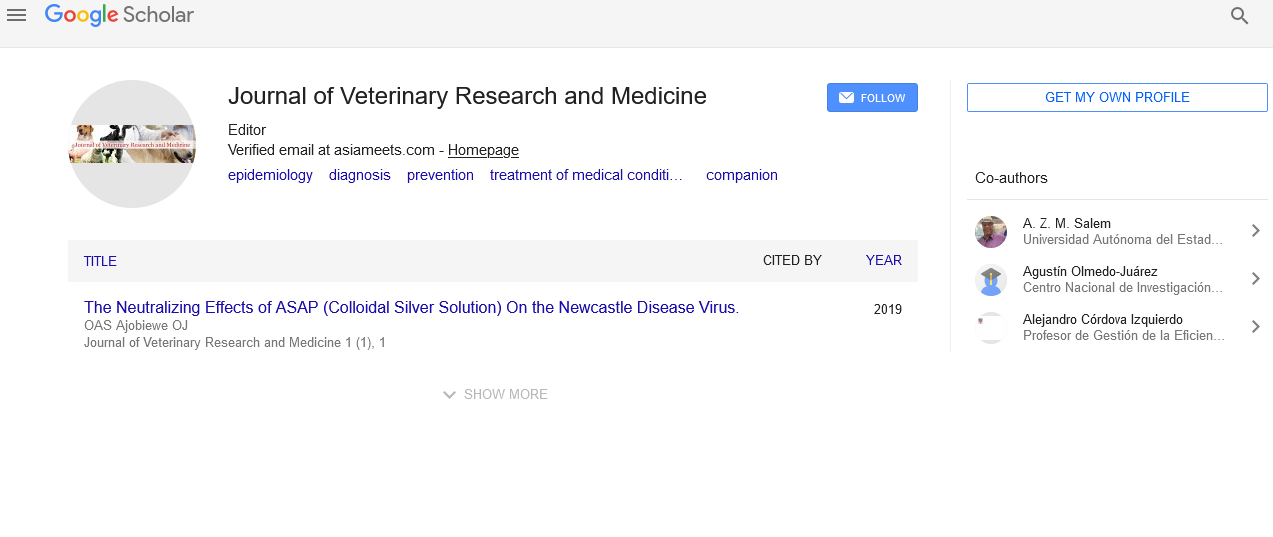Wild life sciences and diseases
Received: 03-Dec-2021 Accepted Date: Dec 17, 2021; Published: 24-Dec-2021
Citation: Fedrickson A. Wild life sciences and diseases. J Vet Res Med.2021;3(3);3.
This open-access article is distributed under the terms of the Creative Commons Attribution Non-Commercial License (CC BY-NC) (http://creativecommons.org/licenses/by-nc/4.0/), which permits reuse, distribution and reproduction of the article, provided that the original work is properly cited and the reuse is restricted to noncommercial purposes. For commercial reuse, contact reprints@pulsus.com
Description
The onset of replica is preceded way of means of a bunch of organismal modifications and transformations, concerning morphological, physiological, and behavioral changes. The timing of those changes, and for that reasons the onset of replica, is encouraged via way of means of numerous elements which include ecological situations including get entry to dietary sources, variations in sociodemographic elements, and genetic variati ons among people. Individuals that increase below one of a kind dietary situations frequently mature at one-of-a-kind rates; that is extensively genuine of animals starting from invertebrates to mammals, and has been documented in numerous primates which include humans.
Observations of this phenomenon commonly help the concept that, in vertebrates, a minimal frame length is needed for maturation, however this frame length may be attained at variable ages. In cattle, for example, puberty takes place after a man or woman has attained approximately 60 percentage of grown-up frame weight, however people range with inside the age at which they gain the edge percentage of grown-up frame length.
Animals developing below terrible dietary situations commonly mature later than the ones experiencing higher nutrition (see opinions) of the literature for primates in such variability in get entry to meals may also rise up among populations dwelling in one-of-a-kind habitats or in environments that modify throughout time, or the variations may also rise up because of social stratification inside an institution. Social stratification expressed as dominance hierarchies in animal societies may also provide upward thrust to variations amongst people in get entry to meals mainly while meals is to be had in restricted quantities or while its distribution is clustered in space. In hierarchically dependent social systems, for example, high-rating people frequently restriction the quantity to which their low-rating opposite numbers get entry to resources. If as a result, high-rating people can differentially provision their young, then parental dominance rank will exert a parental effect, i.e., a parental genotype or phenotype that impacts offspring phenotype with inside the absence of genetic transmission.
We summarize findings on maturation in savanna baboons with inside the Amboseli basin, a semi-arid quick grass savanna in southern Kenya with a big supplement of mammalian herbivores and carnivores. Baboons are sexually dimorphic Old World monkeys that stay in multi male multi girl societies. Group length stages from 10 to two hundred people. Birth takes place after about 6 months of gestation and is accompanied via way of means of a one to two 12 month’s duration of infancy wherein the offspring’s dependence on its mom declines. As is feature of anthropoids, infancy is accompanied way of means of an extended duration of immaturity. Unlike girls, who stay of their natal institution in the course of their lives, adult males disperse across the onset of adulthood, transferring to 1 or a sequence of different agencies over the direction in their lives For the beyond forty years, the baboons of the Amboseli basin of southern Kenya had been the topics of continuous, man or woman-primarily based totally research of lifestyles history, behavior, ecology, and, extra recently, steroid hormones and genetics. In addition, even as the Amboseli baboon populace is on the whole composed of yellow baboons, the populace has skilled a few admixture with Anubis baboons.
Among mammals, primates are characterized via way of means of a notably lengthy duration of increase and development, and that they mature later than different comparable sized mammals. Furthermore, intraspecific research of increase and maturation in lots of anthropoids display intercourse variations in age at each sexual adult hood. In savanna baboons, for example, the 2 sexes comply with the equal bodily increase trajectory till rapidly after common age of menarche, past which adult males diverge from girls of their increase styles and in age at each sexual adulthood and primary replica. This divergence among ladies and men in increase rate, increase duration, and age at sexual adulthood and primary replica, termed sexual bimaturism, is not unusual place amongst anthropoids.





